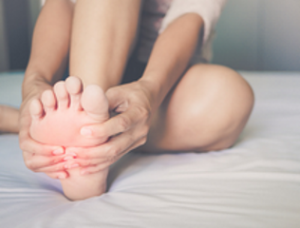For millions of years, humans have treated their conditions with remedies they found in nature, and not powerful drugs. And, while we absolutely agree that medications are needed for many people in many circumstances, pain management for the heel is not necessarily one of those instances.
Our feet really do take a beating every time we move our bodies. They bear the brunt of our weight, yet keep going regardless of how sore or tired they are.
 They endure suffering from ill-fitting shoes and boots, constant pounding on the ground, and repetitive actions from our jobs and hobbies.
They endure suffering from ill-fitting shoes and boots, constant pounding on the ground, and repetitive actions from our jobs and hobbies.
Indeed, our feet are probably the most taken-for-granted parts in our whole bodies.
We just use them and abuse them. And we force them to work whether they should rest or not.
It is no wonder so many of us seek solutions to help our achy, swollen feet. In particular, when discomfort affects our heels, we need to consider calf stretching exercises to soothe heal pain.
What Causes Heel and Calf Pain
Bursitis and Tendinitis
The heel of the foot and the calf in the leg are connected by the Achilles tendon. Both bursitis and tendinitis can contribute to pain in both the calf and the heel. That is why further examination is needed. It is not always clear what exactly is causing the pain.
Scientifically known as the Calcaneal Tendon, from the Latin, tendo calcaneus, a stiff or tight tendon causes pain that can be considered mild all the way to debilitating.
Often, the pain is not immediately felt when the tendon is strained, but rather, starts later, usually when you get up from bed the next day. The persistent activity followed by hours of inactivity ends in intense pain in both the heel and the calf.
Plantar Fasciitis
Another source of discomfort is attributed to plantar fasciitis which involves the inflammation of the tissue that extends between the heal and the toes.
For a lot of people, this is the cause of their heel and calf pain. Stretching of the arches can help to prevent this, and subsequently alleviate the pain.
During-Sleep Leg Stretching
Involuntary stretching while sleeping to the point that the calf ends up with a severe cramp means that the calf tendon is too tight. As a result, in the morning when you get up, there can be associated pain.
Gastrocnemius Equinus
When the gastrocnemius muscle is too short, there is not enough leeway to lift up the heels like when standing on tiptoes. Once you try to raise your heels from the ground, the pain can become extreme.
Can Tight Calf Cause Heel Pain?
Because many people do not understand the physiology of how body elements are related, and how they work in symbiosis, they don’t make the connection between a stiff calf and the corresponding heel pain.
The whole foot can actually become quite sore, making it painful to walk or even put on shoes and boots.
This particular condition is called Gastrocnemius Equinus and results from the muscle, just under the knee in the back of the leg, not being stretched out properly. You can see now why calf stretching exercises to soothe heal pain are beneficial to prevent this condition.
And, another bonus of keeping the gastrocnemius muscle stretched out is that your legs look lovely and toned, which for a lot of individuals is a highly favorable characteristic of the body’s total profile.
Towel Stretch For Heel Pain
This is a really easy stretch that anyone can do, and only requires a towel long enough to go around the bottom of the foot and up to the hands.
Sit on the floor with the legs straight and extended. Place your hands around the knee area, while holding on to the towel that is underneath the toes. Gently pull the towel, while at the same time pulling your foot towards your body.
You should feel the stretch in the heel and calf areas. Hold the pose for about thirty seconds (half a minute), then slowly release. Do eight or twelve repetitions and then change feet.
These type of exercises are efficient for improving pain, as they target the stiff muscles, and reinforce the natural movement of the body’s mechanism in the foot and leg.
How To Stretch Tight Heel Muscles
As we have explained, it is not necessarily the heel itself that is stiff or causing pain. It is often the tendons and tissue connecting the heel to the toes, or the muscles in the calf. Regardless, calf stretching exercises to soothe heal pain will be the solution to your heel problems.
This exercise is a modification of the towel stretch. No towel is needed, as you will move your foot with your hand. Simply sit down on a kitchen chair and place one leg on the other knee. Let the foot dangle and not sit on the knee directly.
Grab a hold of the foot by the toes and move the foot gently towards the body. Again, hold for about thirty seconds and do about eight repetitions until you can manage to do twelve.
How To Heel Bone Spurs Naturally
Heel spurs are tiny growths under the skin which sometimes cause problems in the heel. In many cases, x-rays are need to actually see the spur, although in some instances, a bump can be felt.
But the biggest concern about heel spurs, is not necessarily the spur itself. It has been found that for many people, there is another problem that is primary to the symptoms and diagnosis. The heel spur is secondary, and somewhat incidental.
That doesn’t mean, however, that you don’t want to treat, and heal the heel bone spurs naturally. Two exercises can help improve flexibility for the foot.
They are:
- the Calf Stretch performed using the wall as a support for extended arms,
- and the Plantar fascia Stretch that we have already outlined above.
How To Relieve Aching Heels
Honestly, the fastest and easiest way to subdue aching heels is to start performing some calf stretching exercises to soothe heal pain. Additionally, we recommend:
- stretching the arches,
- stretches to lengthen calf muscles or tendons,
- wearing good supportive shoes,
- and, avoiding high-intensity impact activity until the pain eases.
How To Get Rid of Pain On The Heel
Some suggestions for treating soreness in the heel are:
- Complete a regular and consistent regimen of stretches for foot pain in the heel.
- Sign up for some local Yoga classes or find some online videos that demonstrate yoga stretches for heel pain.
- Learn how to stretch the calcaneal tendon to improve calf flexibility and strengthen the lower leg area.
- Consider using inexpensive heel and arch stretchers that help you complete your daily stretches.
- Revisit your footwear. Is it supportive? Does it fit properly? Is it in good condition, free from wears and tears.
Will Stretching Help Plantar Fasciitis?
In addition to other therapies, medical professionals regularly recommend a routine of stretching in order to treat plantar fasciitis.
It is widely accepted that calf stretching exercises to soothe heal pain will benefit most patients that suffer the awful soreness from inflammation of the tissues found on the bottom of the foot.
Together with stretching out the plantar fascia and Achilles tendon, the exercises will also help improve the strength of the muscles in the lower legs.
Both stretching and strengthening are key to alleviating the pain associated with this condition.
Final Thoughts on Calf Stretching Exercises to Soothe Heal Pain
You have probably realized by now that pain in the heel or calf is multi-faceted, meaning there is a lot going on that makes the human foot actually movable.
We take the foot’s systematic operation for granted, but sadly, that only causes us distress in the form of not only tired, achy feet, but feet that rebel from underlying conditions such as inflamed tissues, stiff tendons, and overworked muscles.
Luckily, there are calf stretching exercises to soothe heal pain available that can restore the foot’s natural agility and healthy environment.


